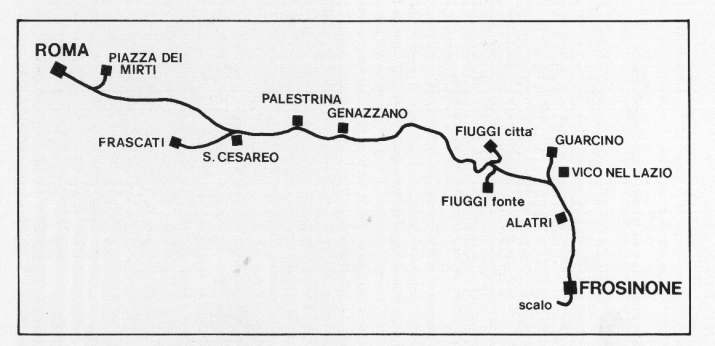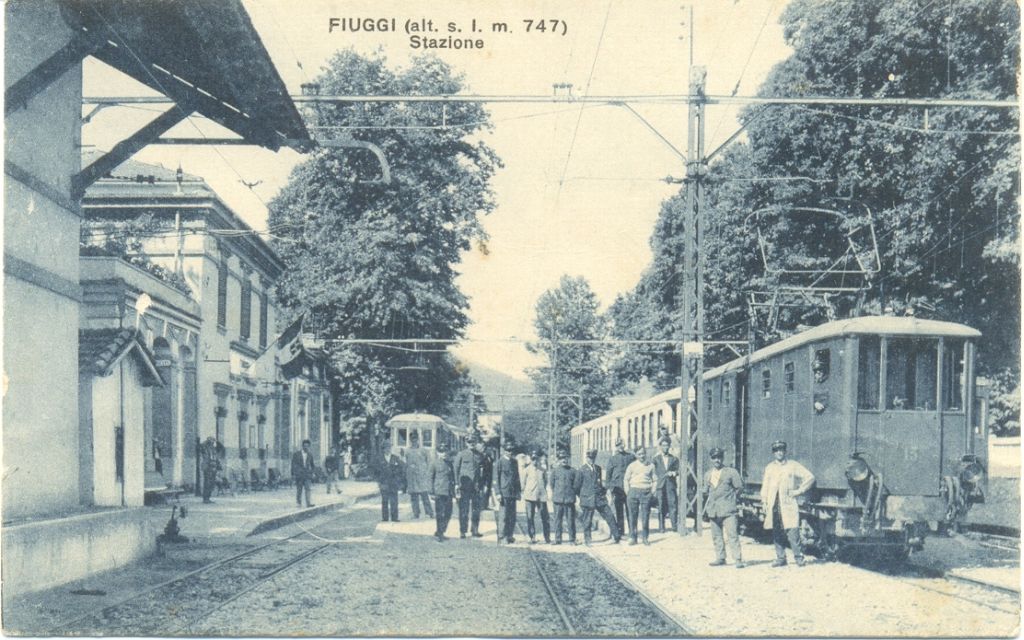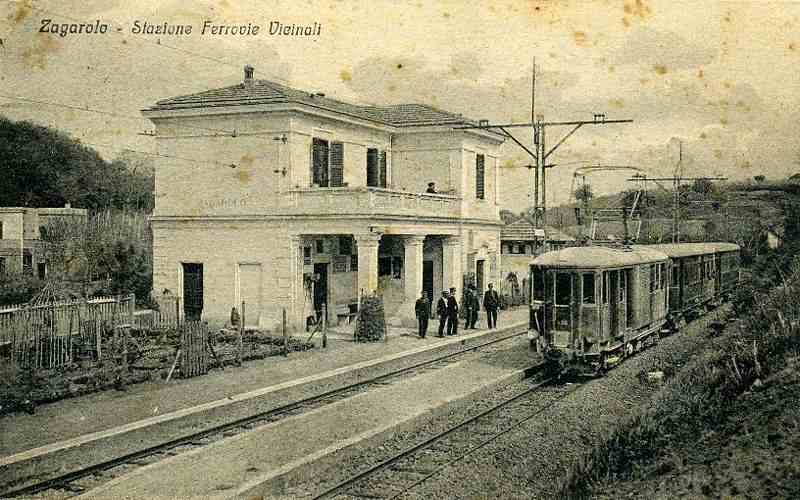
|

... along Prenestina road, near Fiuggi, in the 1920's
Because of the hilly/mountainous territory, and wanting to connect the largest number of settlements, the track was necessarily tortuous and steep. As a consequence of this, a gauge of 95 cm was chosen, already widespread in Italy, and electric traction voltage of 1650 volts direct current.
The slopes reached 60 per thousand and the minimum radius of curves were 45 meters.
On November 20, 1910, after approval by the Ministry of Public Works, the Company for railways vicinal (SFV) was formed, in analogy of Societe Nationale des Chemins de Fer Vicinaux Belgium (SNCV) (see also here).

The electric locomotive n.4 along Casilina road, near San Cesareo.
Today you can visit it, fully restored, at the Ferrovia-Museo
The railway network included the main line between Rome Termini Station and Frosinone (113.0 km) with the following branches:
- Centocelle - Piazza dei Mirti (1.3 km);
- San Cesareo - Frascati (15.2 km);
- CittÓ di Fiuggi - Fiuggi Fonte (4.87 km), and
- Vico nel Lazio - Guarcino (3.43 km), for a total of 137.8 km.
The railway network was opened with the following history:
- June 12, 1916, Rome - Genazzano and San Cesareo - Frascati;
- May 6, 1917, Genazzano - Fiuggi;
- July 14, 1917, Fiuggi - Frosinone, Vico nel Lazio - cittÓ di Guarcino and cittÓ di Fiuggi - Fiuggi Fonte;
- April 28, 1927, Centocelle - Piazza dei Mirti.

The railway network Roma-Fiuggi-Frosinone
Built and managed by the Company "SocietÓ per le Ferrovie Vicinali", it became part of STEFER in 1941.
Created entirely as a single track network it was later doubled from
(1) Roma to Grotta Celoni and, subsequently, to Pantano Borghese (18.4 km)
and (2) from Centocelle to Piazza dei Mirti.

The electric locomotive 811 near Centocelle station, in the 1960's
The
line, notably from Rome to Fiuggi, was immediately affected by a
significant and growing traffic of passengers and goods but also many
tourists who went to Fiuggi for spa treatments. As a consequence of
this, a special first class train considered "fast" was instituted,
with seats upholstered in red velvet with embroidered white lace
headrests.
The rolling stock, which initially
included four small steam locomotives that were used for the
construction of the line, was improved over time by the introduction of
electric locomotives with undercarriage with two and four engines made
by the most well-known national manufacturers and later modernized in
the workshops of Centocelle.
In 1953 the first electric trains of series 801 to 803 built by Stanga / TIBB were introduced that constituted a cutting edge rolling stock, followed in time by three other series.

Fiuggi station in the 1930's
During the sixties with the progressive development of cars, the
construction of the highway "Autostrada del Sole" and the freeway
"Anagni - Fiuggi", the traffic on this railway began to decline.
Instead of implementing projects of correction and improvement, the
politic class inaction, with significant myopia, added to the line's
slow decline until its end in 1984.
One by one the branch lines were closed, and replaced with bus services:
- July 1, 1935, Alatri - Frosinone;
- May 15, 1936, Vico nel Lazio - Guarcino;
- March 1, 1937, cittÓ di Frosinone - Frosinone Scalo;
- San Cesareo - Frascati not rebuilt after the World War II damages;
- June 30, 1960, cittÓ di Fiuggi - Fiuggi Fonte;
- July 1, 1978, Fiuggi - Alatri (restored in 1940);
- May 15, 1982, Centocelle - Piazza dei Mirti;
- December 27, 1983, San Cesareo - Fiuggi;
- February 1984, Pantano Borghese - San Cesareo.

Zagarolo railway station.
1927 postcard
Essential bibliography
De Falco, Franco - L'evoluzione del materiale rotabile e le nuove elettromotrici articolate a tre casse della ferrovia Roma-Fiuggi della societÓ STEFER, estratto da ╔conomie et Tecnique des trnsports, n.1, 1956.
Formigari, Vittorio e Muscolino, Piero - Le Tramvie del Lazio,
storia dalle origini. Calosci-Cortona,
pp. 456, 2004.
Marini, Renzo - La ferrovia Roma-Fiuggi-Alatri; situazione
attuale e prospettive di futuro potenziamento. Ingegneria Ferroviaria, feb 1968.
Muscolino, Piero - Appunti immagini curiositÓ sui tram di Roma e del Lazio. Calosci-Cortona, pp. 208, 2008.